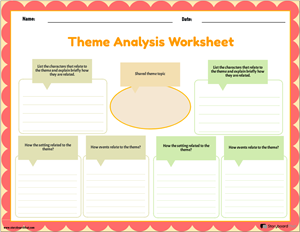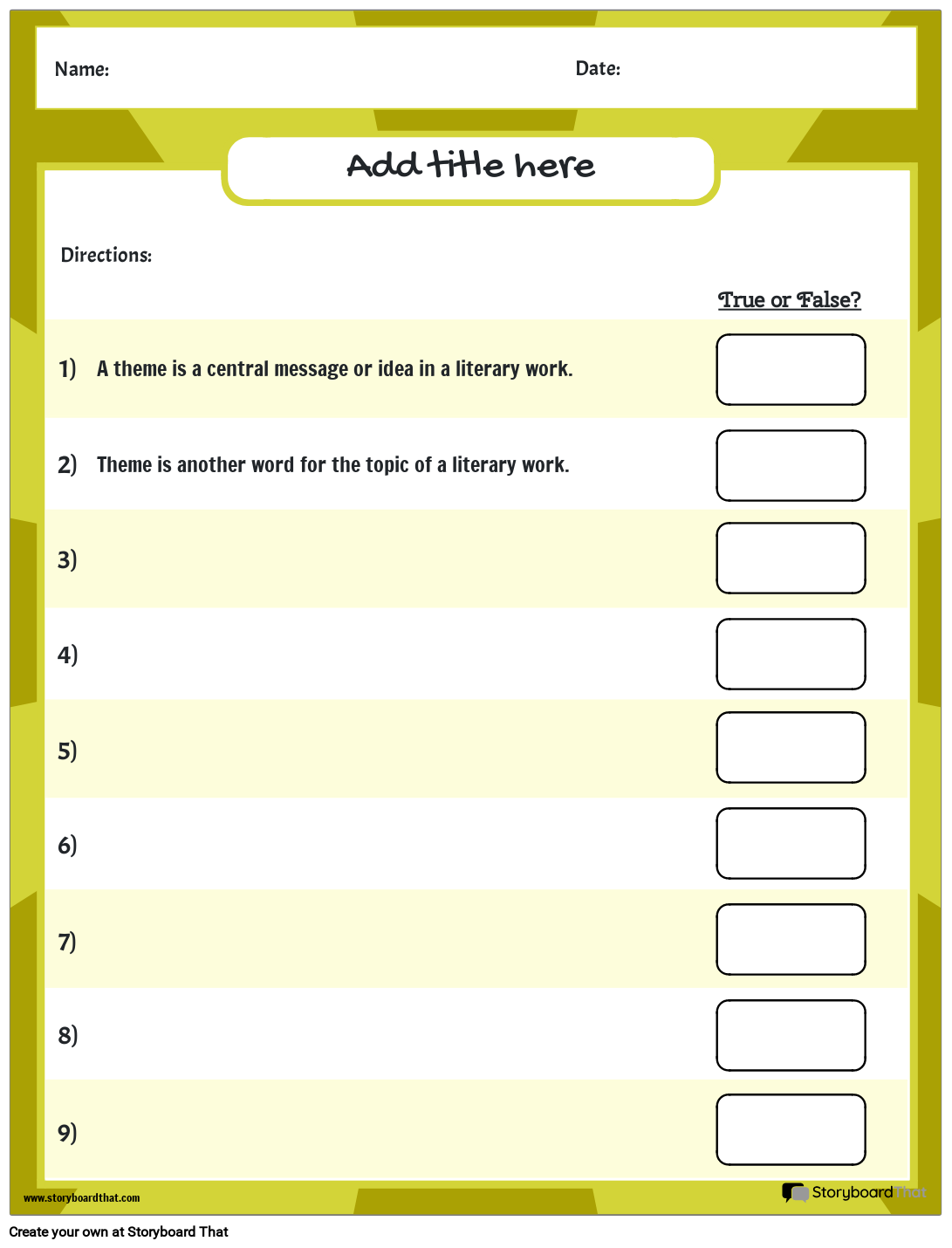Customize Theme Worksheets
If you're assigning this to your students, copy the worksheet to your account and save. When creating an assignment, just select it as a template!

Exploring the Use of Theme Worksheets in the Classroom
These handouts are educational tools used primarily in teaching and learning settings revolving around language arts, literature, and reading. They are designed to help students identify, understand, and analyze the theme of a piece of writing, which can be a book, a story, a poem, or any other literary work. The theme of a literary work is its central message, lesson, or moral.
Here's a brief overview of what they typically include:
- Definition and Explanation: They often begin with a section that defines what a theme is and how it differs from other literary elements like plot and characters.
- Examples: They may provide examples of common themes such as love, friendship, courage, or the battle between good and evil to give a clearer understanding.
- Guided Practice: Handouts usually include excerpts from texts with guided questions that help kids identify the theme. These questions may ask kids to consider the actions of characters, the main idea or central idea, the outcomes of the plot, and the statements made by the narrator or characters.
- Independent Practice: Students might be given a short story or a passage to read on their own, followed by questions that guide them to identify and analyze the theme.
- Critical Thinking and Analysis: Advanced worksheets may include sections that encourage readers to compare themes across different texts or to analyze how they are developed through various literary devices.
- Creative Application: Some might also include creative prompts that encourage children to write a short piece or create a project that reflects a certain theme.
- Discussion Questions: For group learning settings, worksheets can include discussion questions to facilitate conversation in a collaborative environment.
Tips for Making a Worksheet
- Select an Example: Begin by choosing a clear and engaging example relevant to your curriculum. This could be a universal theme like courage, friendship, or resilience.
- Use a Theme Generator: Utilize a theme generator tool to create varied and interactive content. This tool can help you design custom worksheets tailored to the chosen literary theme and the learning level of your class.
- Design: Structure your worksheet to include sections for theme in reading. Include a brief text or excerpt and create questions that guide readers in understanding the lesson.
- Incorporate Activities: Add interactive activities to the worksheet. These could be creative writing prompts, group discussions, or role-playing scenarios.
- Provide an Answer Key: Ensure that each worksheet comes with an answer key. This key should not only provide correct answers but also explain why they are correct, to aid in theme practice for middle school students and beyond.
- Include a Theme Organizer: Finally, add an organizer section in the worksheet. This could be a chart or a mind map for students to organize their thoughts and findings.
Activity Ideas
- Comparative Analysis Activity: Use worksheets where kids compare and contrast themes in two different texts. Provide a key for reference, allowing the class to check their analyses and understand different perspectives.
- Story Creation Activity: In this activity, children use a provided organizer to create their own short stories. This exercise, particularly suitable for middle school students, encourages creativity while focusing on incorporating a clear theme.
- Group Discussion and Identification Activity: Utilize a theme practice worksheet where students read a text in groups and work collaboratively. They can use the handout to guide their discussion and document their findings.
- Exploration with Visual Aids: In this theme for students activity, they use handouts alongside visual aids like movies or paintings to identify and compare across different mediums. This can be an engaging way to explore how themes are represented differently.
- Case Studies: Implement an activity using worksheets where readers analyze real-life scenarios or case studies. They can use the organizer to dissect the underlying themes present in these real-world examples, making the learning process more practical and relatable.
- Literature Circles for Analysis: Organize literature circles where each group is given a different text and a handout. Each group discusses their assigned text and presents their analysis to the class, using the identifying theme answer key to guide their presentation and discussion.
More Storyboard That Free Resources and Free Printables
- Main Idea and Details Worksheets
- Making Connections Worksheets
- Making Predictions Worksheets
- Nonfiction Text Structures Worksheets
- Plot Diagram Worksheets
- Point of View Worksheets
- Reading Logs Worksheets
- Reading Responses Worksheets
How to Make a Theme Worksheet
Choose One of the Premade Templates
We have lots of templates to choose from. Take a look at our example for inspiration!
Click on “Copy Template”
Once you do this, you will be directed to the storyboard creator.
Give Your Worksheet a Name!
Be sure to call it something related to the topic so that you can easily find it in the future.
Edit Your Worksheet
This is where you will include directions, specific images, and make any aesthetic changes that you would like. The options are endless!
Click "Save and Exit"
When you are finished, click this button in the lower right hand corner to exit your storyboard.
Next Steps
From here you can print, download as a PDF, attach it to an assignment and use it digitally, and more!
Happy Creating!
Frequently Asked Questions about Theme Worksheets
How do theme worksheets enhance understanding in reading?
They encourage kids to think critically about the underlying messages in a text, improving their comprehension and analytical skills in reading.
Can theme worksheets be used for cross-curricular learning?
They can effectively facilitate cross-curricular learning by connecting themes in literature with concepts from various disciplines. They enable learners to explore historical and cultural contexts in language arts and social studies, examine scientific themes and their real-world applications in science classes, and express literary themes through art and music. In math, they can relate to key details in logic and problem-solving, while in civic education, they can convey themes related to governance and social responsibilities.
How do theme worksheets improve reading comprehension?
They improve reading comprehension by encouraging students to look beyond the surface details of a story drama or poem, and understand the deeper meanings, message, and moral lessons conveyed, enhancing their reading skills and their ability to interpret and understand literature.
© 2025 - Clever Prototypes, LLC - All rights reserved.
StoryboardThat is a trademark of Clever Prototypes, LLC, and Registered in U.S. Patent and Trademark Office
















